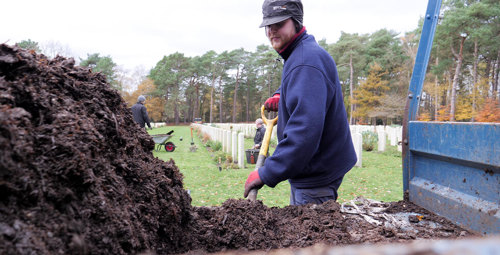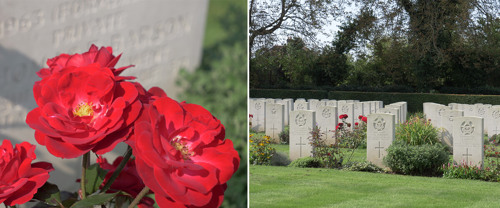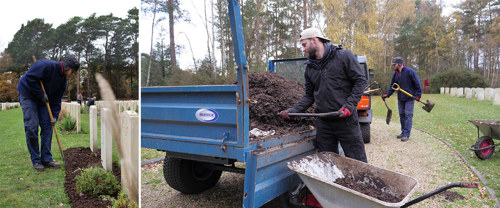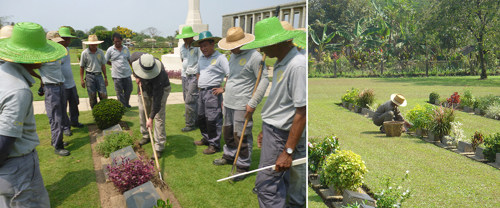12 February 2021
Why Does Soil Health Matter?
Discover why soil type and keeping the ground healthy is so important for our cemeteries across the world. Adam Blunt, CWGC’s Horticulture Training Manager, explains more and offers some helpful tips for maintaining your garden at home.

Our gardeners operate across the globe in a variety of landscapes, terrains, and environments but the cornerstone to our horticultural success is maintaining and improving soil health. Plants require several things from the soil including anchorage (support), water, air, and nutrients.
Soil types can vary drastically dependant on the ratios of clay, silt, and sand, and sometimes there are additional materials like stones and chalk which can change the composition. Clay soils are usually heavy and fertile and can become compacted or waterlogged, while sandy soils are lighter and well drained, but less fertile. As a general guide, roll a small lump of damp soil in your hand: if it is sticky and makes a ball, it is a clay loam soil, and if it is gritty and falls apart, it’s sandy.

Oxford Botley Cemetery, Oxfordshire
Another factor our gardeners must consider is the pH of the local soil, this can be tested with a simple pH testing kit or probe and will identify if your soil is alkaline, acidic, or neutral soil. Within plant borders it is not practical to try and change the pH of soil, so the key is to understand the soil you have and select appropriate plants for those conditions. For example, on Acid soils you may select Pieris japonica or Calluna vulgaris (Summer Heather) whereas for alkaline soils you may consider Cytisus (Broom) or Potentilla.
Soil and site conditions are one of the many reasons you may see different planting displays at our sites. Selecting the right plant for the right place helps your plants thrive and reduces the chance of failure.

Adding mushroom compost at Brookwood Military Cemetery, Surrey
Here are some of the ways our gardeners improve the health of soils:
ADDING BULKY ORGANIC MATTER
One of the most effective methods is by adding organic matter to the surface of a border e.g. well-rotted farm manure or spent mushroom compost to plant borders. This can encourage useful soil organisms, insulate the soil, and help retain nutrients. A key benefit of incorporating organic material is that on poorly draining soils it can improve drainage and accessibility of nutrients, on free draining sandy soils it can help retain moisture and nutrients. Adding organic material will also encourage beneficial soil organisms an essential requirement for good soil health.
MANAGING WEEDS
Weeds compete with plants for water, nutrients and sunlight so need to be removed from plant borders. They can also harbour pests and diseases that we want to keep out. Ideally the physical removal of weeds is preferred over the application of herbicides that can damage organisms and can lead to accidental damage of surrounding plants.
REDUCING CULTIVATION
Many studies have found that over cultivating soils can damage the soil structure which will impact on water and air movement within the soil. The ‘no dig’ principle of applying organic matter and mulches can improve soil structure without the need for digging and cultivation.
USE IT OR LOSE IT!
Areas of bare soil should be avoided as the effects of weather can cause compaction and capping of the soil, reducing the soil’s ability to exchange air and water. Borders should be full, with minimal bare soil to reduce open space for weeds to grow and minimise water loss. Where you may have bare ground on an allotment between seasonal cropping it may be a good idea to sow a green manure like Mustard (Sinapis alba), this can then be cultivated back into the ground adding nutrients and organic material.

Border weeding in Taukkyan War Cemetery, Myanmar
Did you know that you can order a free pack of wildflower seeds to grow you own remembrance garden at home? Here are some of my top tips for preparing a small area for sowing the seeds:
- Lightly fork over and cultivate the area removing any weeds, large stones, or other debris.
- Rake the area to level the ground and break down and large lumps
- Gently press the ground down again with the back of the rake or by walking over the area
- Finally rake the soil to a fine tilth (tilth is the surface crumb of the soil).
- Generally, wildflowers will grow on less fertile ground, so you don’t need to add any extra fertiliser.
- You now have a seedbed ready for the wildflower mix, planting instructions can be found on the packet.


